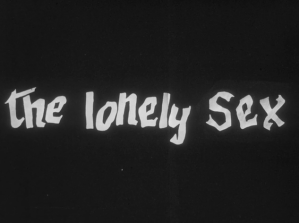 Directed by Alex Nicol
Directed by Alex Nicol
Featuring Peter Carpenter, Dyanne Thorne, Joel Marston, Lory Hansen and Paula Mitchell
Tony Trelos is a sub-Tom Jones style singer who does his thing down at the Lobster House twice a night. Our film opens to Tony, on stage in a tight, bright red jumpsuit decorated with extremely long fringe, belting out a tune while doing some pretty questionable dance moves. As the song ends, Tony screams and wakes up on the beach.
Here he is approached by an older woman in a bikini. This is Andrea (played by Ilsa herself, Dyanne Thorne!), and she informs him that he is on her private beach. But she doesn’t mind – and as they flirt she agrees to come and see him perform sometime soon.
Andrea is as good as her word – she goes to the Lobster Shack and is mesmerised by Tony hamming it up on stage. She reveals that she is married to the boss of a record label, Martin (who is a partial invalid in a wheelchair), and implies that she can get Tony a contract. Against the advice of Tony’s girlfriend Sally, he goes for it, embarking on an affair with Andrea in exchange for being signed up to the record label.
As Andrea and Tony continue their shenanigans, Martin becomes increasingly jealous, and Andrea’s instability becomes more obvious. Martin and Andrea have more and more drunken arguments, and it all comes to a head one night when Martin sees Andrea and Tony having sex in the pool. He confronts Andrea, and they have a bizarre fight where Andrea pushes poolside furniture into his wheelchair and shouts ‘Toro! Toro!’, taunting him as the sounds of a bull fight play in the background. Martin’s wheelchair slips into the pool, and Andrea doesn’t lift a finger to save him from this ‘accident’.
At Martin’s funeral, Tony catches a glimpse of Helayne, Andrea’s stepdaughter – and the inheritor of the half of the record company fortune that is not Andrea’s. After the funeral Tony proposes to Andrea, who laughs in his face, confirming his mere sex toy status. Soon enough, he marries the pretty but boring Helayne instead. But it’s not all happy endings: not only is there still the bitchy and vindictive Andrea to contend with, but Tony’s ex Sally turns up pregnant and despairing of what to do about it.
Although the description on the DVD case and on IMDb make it sound like this is a horror movie, it really has minimal horror elements. It is an examination of personal exploitation of various kinds, wrapped in the form of an over the top and very 1970s soap opera. It is a parade of garish lighting and even more garish fashion, unhinged behaviour and a preening performance from the at best modestly talented Peter Carpenter as Tony. He is someone who exudes the sense that he believes he is the most handsome man in any given room, but who in reality looks older and more leathery than he thinks he does, and is creeping everyone out a little with his dance moves. It’s all gloriously entertaining, particularly given that from the title I was expecting this would be a half-baked horror movie.
[*SPOILERS*] The climax of the film takes place up on a cliff top, as Tony reveals to a disdainful Andrea that he and Helayne are married. Andrea is initially bitterly triumphant because the marriage negates Helayne’s inheritance. But when that isn’t enough to send Tony running back to her, Andrea spits venomous insults at him, whines, cries and generally has a giant tantrum, eventually grabbing onto his ankles so that he walks around dragging her along the lawn. Still clinging to him, she clamps her arms around his shoulders, and Tony starts spinning around (?!) until the centrifugal force causes her to be flung away, over the cliff and to her death on the rocks below (!!).
Just when you think it’s all over, there is an odd scene of a detective investigating this ‘accident’ while eating an array of snacks off a food platter left out by the pool from the night before. Tony gets off scott free and is just about to fly out on a trip with Helayne, but gets a last minute call from Sally. When hee goes to see Sally and find out what’s wrong, the pregnant Sally shoots him. He done her wrong, after all. As Tony lies dying, we hear him scream again – and then he’s back lying on the beach, meeting Andrea for the first time. Of course, it was all a dream. Or maybe a very extended premonition, one full of an incredible amount of interpersonal drama, murders disguised as accidents, and bad singing. [*END SPOILERS*]
This film is one hell of a ride. Catch it if you can – the mix of the super-vain Tony, his many sexy, slightly unhinged women, the ridiculous super-dramatic story and general 70s atmosphere make it as entertaining as it is bad.
Worth watching? Yes! It is not good, but there is never a dull moment (and plenty of jaw dropping ones).
Truth in advertising? The title really has nothing at all to do with the story, and comes across as falsely trying to advertise it as a horror movie: 0/5.


 AKA: Lèvres de Sang
AKA: Lèvres de Sang
 Directed by William McGann
Directed by William McGann Directed by Alex Nicol
Directed by Alex Nicol
 Directed by Peter Strickland
Directed by Peter Strickland Directed by Richard Hilliard
Directed by Richard Hilliard Directed by Anthony Farrar and an uncredited Joseph W. Sarno
Directed by Anthony Farrar and an uncredited Joseph W. Sarno